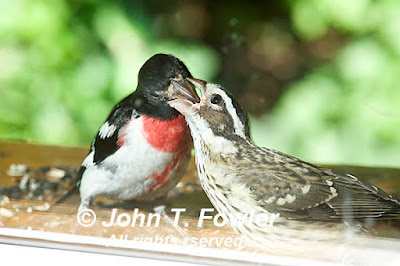The grass is riz.
Are you wondering where them birdies is?
Well, wonder no more.
Cuz they are in our backyard.
Yup.
At least a gazillion of them.
The rose-breasted grosbeaks have been here for a while now. They are the noisiest damned things you ever heard. But gosh they're beautiful birds.
On Wednesday, our first hummingbird arrived -- easily a week early.
He zoomed in looking for food -- zeroed in right to the spot where there would normally be a feeder.
I spotted him through the window while I was watching television. You never saw anyone jump up so fast to get bird nectar ready!
The bird flitted to each of the three locations where we normally have a feeder for these little wonders.
I couldn't get those feeders filled and in situ fast enough I tell you. By this morning, we know that at least three others have arrived. Before too much longer, there will be many more to entertain us.
I love watching hummingbirds flit about the place. We'll have quite a show as the first -- more aggressive bird -- protects his territory. He darts madly from one feeder to the other fending off any other bird that tries to partake at any one of the three feeders. I call him "greedy bugger."
We're also inundated with goldfinches -- they love sunflower chips. We can't keep the feeder filled fast enough for them! What a gorgeous bird they are. They also enjoy sunflower seeds but the chips are the real attraction for them.
That's a purple finch ignoring the two sparring goldfinches.
That's a purple finch ignoring the two sparring goldfinches.
Our kitchen window sill sports a platform on which we supply sunflower seeds for the chickadees and the pine siskins.
The grosbeaks also visit the window sill in great numbers, and when it comes time to feed their young, that's when the real fun starts! These guys scream from dawn to dusk. Enough to wake the dead I tell you. Sometimes, their crying drowns out the television in the next room.
It's really something to watch the performance the young ones put on too. If they are on the ledge alone, they'll feed themselves. But as soon as an adult bird shows up, they become incapable of feeding, and the crying starts. (Sometimes, they're eating and crying at the same time.)
Usually, it's the male that gives in and feeds them, probably because he can't stand the racket any longer (much like the human race?). Mom -- like Moms everywhere -- can ignore the whining. She likely figures it's time the young started earning their own way. Which, in this environment, isn't too difficult since we're spending a king's ransom keeping them in feed. I once observed an adult male trying to ignore the cries of the young bird. And the young'un actually charged at the adult, insisting that he feed him!
We often wonder if these birds might have difficulty when it's time to leave for the south -- they'll truly need better survival skills than are required around here. At least they'll have good fat reserves!
Our suet feeder is kept filled all year round for the three pileated woodpeckers that visit regularly. It's a delight every time one, two or sometimes all three are there at the same time.
We're hoping that this year we'll again be treated to the display of mommy feeding her babies. Fascinating show, that!
The suet feeder also attracts grackles (which I hate -- they remind me of Alfred Hitchcock's movie, "The Birds"), blue jays (yet another terribly noisy bird), and red winged blackbirds (another gorgeous bird):
Our resident robin has arrived too, busily building a nest over the porch. I wonder if we'll have our crazy guy fighting with his reflection in our living room window again this year?
A couple of years ago, an oriole had come through, checking out the hummingbird feeders. So we rushed out and bought an oriole feeder, hoping he would stay around. We never did see him again. But yesterday, John saw one scoping out the neighbourhood. He saw him again this morning. So the oriole feeder is filled and back in place. We're really hoping he'll find it and stay with us this year.
As I said, if you're wondering where them birdies is ...








No comments:
Post a Comment